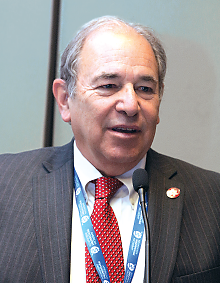An 11-year-old boy and his mother visit the pediatrician’s office for a routine physical for summer camp. During the visit, the mother says that the child has had difficulty paying attention, suggesting to the pediatrician symptoms of ADHD.
A 17-year-old girl presents in the pediatrician’s office with poorly controlled diabetes. In discussions with the girl and her mother, it becomes apparent that the child has not been able to comply with the treatment regimen, in part because of conflict and stressors in the family.
A 15-year-old boy is discharged with prescriptions for more than one psychiatric medication and begins to experience serious side effects related to adverse interactions. It could take months to schedule an appointment with a private-practice psychiatrist.
In each of these cases, a team-based, integrated system of care could benefit the child or adolescent patient by extending psychiatric expertise to the primary care setting.
So say a growing number of child and adolescent psychiatrists, including Gregory Fritz, M.D., president of the American Academy of Child and Adolescent Psychiatry (AACAP), who has made integrated care his presidential initiative for his 2015-2017 term.
In an interview with Psychiatric News, Fritz said that in each of the vignettes described above, child psychiatrists—participating in something like the collaborative care model developed by Jürgen Unützer, M.D., M.P.H., and others at the University of Washington—would work in a consultative role with a pediatrician to provide mental health care in the pediatric setting. Each vignette describes a slightly higher level of direct involvement by the psychiatrist:
•
For the 11-year-old, screening for ADHD could be performed by pediatric office staff using standardized diagnostic instruments. If indicated, medication could be prescribed by the pediatrician, with periodic consultation with the child psychiatrist to monitor progress, symptoms, and side effects.
•
For the 17-year-old, a behavioral health specialist working in the pediatrician’s office could work with the family to identify and manage stressors contributing to poor adherence to the diabetic treatment regimen.
•
In the case of the discharged 15-year-old experiencing severe side effects from multiple medications, the child psychiatrist might arrange to evaluate the patient directly during a periodic site visit to the pediatrician’s office.
As in integrated care models serving the adult population, a collaborative care model for children extends psychiatric expertise to the pediatrician’s office while preserving the child and adolescent psychiatrist’s scarce time to focus on patients with complex conditions and serious emotional disturbance.
It’s better for the patient, pediatrician, and psychiatrist and better for the cause of population health, Fritz said. “Kids and their parents prefer to receive care if possible in the primary care setting,” he told Psychiatric News. “There’s less stigma than is associated with going to a psychiatrist’s office, and there already exists a level of trust and respect in a familiar location.”
The numbers on physician workforce and child and adolescent mental health needs support the value of a new, more efficient approach to meeting those needs: according to the National Alliance on Mental Illness, 21 percent of children and adolescents aged 9 to 17 have a diagnosable mental or addictive disorder with at least minimal impairment, and 6 to 9 percent have a serious disorder causing significant impairment. Yet there are fewer than 9,000 child and adolescent psychiatrists to meet the need, and it is believed that 80 percent of the children in the United States with serious psychiatric disorders receive no services at all.
When Fritz became AACAP president in 2015, he brought to the office a career-long interest in working across medical disciplines. “As a child and adolescent psychiatrist with a longstanding career interest in consultation-liaison, working on the boundary between pediatrics and psychiatry, I jumped on integrated care for my presidential theme, and it has been embraced by the academy leadership and membership,” Fritz told Psychiatric News.
Fritz chairs a 12-member task force on integrated care. One project of the task force has been the creation of the online Pediatric Integrated Care Resource Center, which has an enormous bounty of information, including information about existing pediatric integrated programs and projects around the country; a library of peer-reviewed published research, policy statements, and white papers by various institutions for use in advocacy; educational resources for medical school and residency educators; a repository of instruments for measuring outcomes in pediatric integrated care; and related website links.
Fritz invites psychiatrists to use the website to report their programs and projects in pediatric integrated care and to share information with other clinicians about what works and what doesn’t.
Additionally, the task force is finalizing an issue of the journal Child and Adolescent Psychiatric Clinics of North America, which will have 20 articles on state-of-the-art aspects of pediatric integrated care, due for release this fall.
Yet for all the momentum that would appear to be behind the movement toward integrated care, there remain barriers that are unique to child and adolescent psychiatry. The principal barrier has been financial. Ronald Szabat, director of government affairs and clinical practice at AACAP, said the academy has backed APA efforts to secure payment codes for participation of psychiatrists in collaborative care. (In the recently released 2018 proposed Medicare Fee Schedule, CMS plans to adopt new codes for Collaborative Care Model services and behavioral health integration services to replace the current temporary codes;
Psychiatric News, August 18).
Moreover, the potential return on investment associated with prevention may be enormous—but it accrues much later, making it difficult to persuade payors interested in short-term returns to make the investment.
Fritz said that while there are similarities between pediatric and adult integrated care systems, the differences are notable. One of these is in the area of prevention.
“Prevention is a critical component of treating children in integrated care, and an opportunity that is more realizable than in adult populations,” he said. “But in our fee-for-service system, the patient needs a diagnosis in order for the clinician to get paid. If you are treating a child who is pre-diagnosis, you don’t get paid. That’s a problem.”
Fritz said it is difficult to gauge how many clinicians are engaged in some form of integrated care, but he estimated it is “probably a minority.” One example is child and adolescent psychiatrist Adair Parr, M.D., who in addition to her private practice in child psychiatry works as a staff psychiatrist, three days a week, at Potomac Pediatrics in Rockville, Md. (
Psychiatric News, August 4).
Parr’s work falls under what is known as the “hybrid” model; she works partly as an on-site psychiatrist seeing patients in the office and partly in a consultative role to the primary care physician. She is one of some 80 APA members who have participated in or completed one of APA’s Online Learning Collaboratives, offered as part of APA’s participation in the federal government’s Transforming Clinical Practice Initiative.
Fritz said that the most crucial change necessary for the adoption of the pediatric integrated care model may involve the culture and mindset among child and adolescent psychiatrists themselves.
“We need to change our mindset from the traditional, isolated, siloed office practice with a 50-minute hour to a different kind of practice that is much more consultative, in collaboration with pediatricians and primary care staff,” he said. ■
AACAP’s Pediatric Integrated Care Resource Center can be accessed
here. AACAP’s Pediatric Integrated Care Resource Center is available
here.


